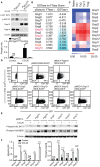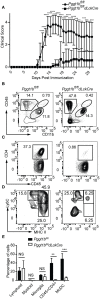A Requirement of Protein Geranylgeranylation for Chemokine Receptor Signaling and Th17 Cell Function in an Animal Model of Multiple Sclerosis
- PMID: 33828552
- PMCID: PMC8019753
- DOI: 10.3389/fimmu.2021.641188
A Requirement of Protein Geranylgeranylation for Chemokine Receptor Signaling and Th17 Cell Function in an Animal Model of Multiple Sclerosis
Erratum in
-
Corrigendum: A Requirement of Protein Geranylgeranylation for Chemokine Receptor Signaling and Th17 Cell Function in an Animal Model of Multiple Sclerosis.Front Immunol. 2021 Apr 19;12:687135. doi: 10.3389/fimmu.2021.687135. eCollection 2021. Front Immunol. 2021. PMID: 33953734 Free PMC article.
Abstract
Precisely controlled lymphocyte migration is critically required for immune surveillance and successful immune responses. Lymphocyte migration is strictly regulated by chemokines and chemokine receptors. Here we show that protein geranylgeranylation, a form of post-translational protein lipid modification, is required for chemokine receptor-proximal signaling. Mature thymocytes deficient for protein geranylgeranylation are impaired for thymus egress. Circulating mature T cells lacking protein geranylgeranylation fail to home to secondary lymphoid organs or to transmigrate in response to chemokines in vitro. Mechanistically, protein geranylgeranylation modifies the γ-subunits of the heterotrimeric small GTPases that are essential for chemokine receptor signaling. In addition, protein geranylgeranylation also promotes the differentiation of IL-17-producing T helper cells while inhibiting the differentiation of Foxp3+ regulatory T cells. Finally, mice with T cell lineage-specific deficiency of protein geranylgeranylation are resistant to experimental autoimmune encephalomyelitis induction. This study elucidated a critical role of protein geranylgeranylation in regulating T lymphocyte migration and function.
Keywords: T cells; adaptive immune response; autoimmunity; lymphocyte migration; protein geranylgeranylation.
Copyright © 2021 Swan, Geng, Park, Ding, Zhou, Walcott, Zhang, Huang, Hammer and Wang.
Conflict of interest statement
The authors declare that the research was conducted in the absence of any commercial or financial relationships that could be construed as a potential conflict of interest.
Figures







Similar articles
-
IL-9 promotes Th17 cell migration into the central nervous system via CC chemokine ligand-20 produced by astrocytes.J Immunol. 2011 Apr 1;186(7):4415-21. doi: 10.4049/jimmunol.1003307. Epub 2011 Feb 23. J Immunol. 2011. PMID: 21346235
-
IL-7/IL-7 Receptor Signaling Differentially Affects Effector CD4+ T Cell Subsets Involved in Experimental Autoimmune Encephalomyelitis.J Immunol. 2015 Sep 1;195(5):1974-83. doi: 10.4049/jimmunol.1403135. Epub 2015 Jul 29. J Immunol. 2015. PMID: 26223651 Free PMC article.
-
B7-H1 Selectively Controls TH17 Differentiation and Central Nervous System Autoimmunity via a Novel Non-PD-1-Mediated Pathway.J Immunol. 2015 Oct 15;195(8):3584-95. doi: 10.4049/jimmunol.1402746. Epub 2015 Sep 16. J Immunol. 2015. PMID: 26378076
-
Using EAE to better understand principles of immune function and autoimmune pathology.J Autoimmun. 2013 Sep;45:31-9. doi: 10.1016/j.jaut.2013.06.008. Epub 2013 Jul 9. J Autoimmun. 2013. PMID: 23849779 Free PMC article. Review.
-
Transcription factors and th17 cell development in experimental autoimmune encephalomyelitis.Crit Rev Immunol. 2013;33(2):165-82. doi: 10.1615/critrevimmunol.2013006959. Crit Rev Immunol. 2013. PMID: 23582061 Review.
Cited by
-
Uncovering protein prenylation in Th1 cells: novel prenylation sites and insights into statin and farnesyltransferase inhibition.BMC Biol. 2025 Jul 31;23(1):233. doi: 10.1186/s12915-025-02345-1. BMC Biol. 2025. PMID: 40745647 Free PMC article.
-
Regulation of Adaptive Immunity by Lipid Post-translational Modifications.Immune Netw. 2025 Feb 18;25(1):e11. doi: 10.4110/in.2025.25.e11. eCollection 2025 Feb. Immune Netw. 2025. PMID: 40078786 Free PMC article. Review.
-
Structural Insight into Geranylgeranyl Diphosphate Synthase (GGDPS) for Cancer Therapy.Mol Cancer Ther. 2024 Jan 3;23(1):14-23. doi: 10.1158/1535-7163.MCT-23-0358. Mol Cancer Ther. 2024. PMID: 37756579 Free PMC article. Review.
References
Publication types
MeSH terms
Substances
Grants and funding
LinkOut - more resources
Full Text Sources
Other Literature Sources
Molecular Biology Databases

